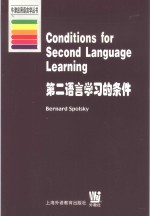

第二语言学习的条件 英文PDF电子书下载
- 电子书积分:11 积分如何计算积分?
- 作 者:(以色列)Bernard Spolsky著
- 出 版 社:上海:上海外语教育出版社
- 出版年份:2000
- ISBN:7810468596
- 页数:272 页
ContentSIntroduction 1
The task of a general theory 1
Other models 5
1 A general theory of second language learning 11
Features of a general theory 11
Conditions for second language learning 14
An overview 25
Interlanguage 30
2 Knowing a language 30
Variability 36
Variety of language 41
3 Knowing how to use a language 46
Duality of knowledge and skills 46
Communicative competence 51
The view from theory 56
4 Structures and functions 59
The approach from language testing 59
Testing structural knowledge 60
Testing integrated functions 61
Necessary or imposed order 65
Goals for learning Hebrew—an example 66
5 Measuring knowledge of a second language 71
The idea of general proficiency 71
Relating the models 76
Linguistic outcomes in a general theory 78
6 The psycholinguistic basis 83
The human learner 83
The argument from linguistic theory 89
The relevance of age 91
7 Ability and personality 100
Individual differences 100
Intelligence 102
Aptitude 104
Learning styles and strategies 108
Personality 110
Anxiety in second language learning 113
8 The linguistic basis 117
Contrastive analysis 117
Universals and contrastive analysis 121
Universals and second language learning 124
9 The social context 131
Social factors 131
The stylistic dimension 136
The acculturation model 142
10 Attitudes and motivation 148
Language learning motivation 148
The socio-educational model 154
Attitudes,motivation,and acculturation 157
Social basis of motivation 160
11 Opportunities for second language learning 166
Opportunities for learning 166
Informal and formallearning 170
Pidginization and creolization 173
Foreigner talk 178
12 Formal instruction 187
The nature and effect of input 187
The value of formalinstruction 193
The approach from teaching 197
Testing a preference model 202
13 Testing the model 202
Defining the outcomes 204
Ability and personality 205
Anxiety 207
Attitudes and rationales 207
The effects of attitudes 209
Opportunities for learning 211
A causal model 213
Choosing a model 221
14 The form of a general theory 221
Beyond the preference model 225
Extension of the theory to language loss 228
Conclusion 229
AppendixCase study:Hebrew in a Jewish school 232
The case study 232
The reliability and validity of self-assessment 233
Tables 235
Bibliography and citation index 244
Index 265
- 《女丹仙道:道教女子内丹养生修炼秘籍 下》董沛文著 2012
- 《异质性条件下技术创新最优市场结构研究 以中国高技术产业为例》千慧雄 2019
- 《党员干部理论学习培训教材 理论热点问题党员干部学习辅导》(中国)胡磊 2018
- 《程序逻辑及C语言编程》卢卫中,杨丽芳主编 2019
- 《幼儿园课程资源丛书 幼儿园语言教育资源》周兢编 2015
- 《深度学习与飞桨PaddlePaddle Fluid实战》于祥 2019
- 《全国普通高等中医药院校药学类专业“十三五”规划教材 第二轮规划教材 有机化学学习指导 第2版》赵骏 2018
- 《高等学校“十三五”规划教材 C语言程序设计》翟玉峰责任编辑;(中国)李聪,曾志华,江伟 2019
- 《音乐语言的根基》张艺编著 2019
- 《认知语言学视野的抽象方位结构研究》曹爽著 2019
- 《中风偏瘫 脑萎缩 痴呆 最新治疗原则与方法》孙作东著 2004
- 《水面舰艇编队作战运筹分析》谭安胜著 2009
- 《王蒙文集 新版 35 评点《红楼梦》 上》王蒙著 2020
- 《TED说话的力量 世界优秀演讲者的口才秘诀》(坦桑)阿卡什·P.卡里亚著 2019
- 《燕堂夜话》蒋忠和著 2019
- 《经久》静水边著 2019
- 《魔法销售台词》(美)埃尔默·惠勒著 2019
- 《微表情密码》(波)卡西亚·韦佐夫斯基,(波)帕特里克·韦佐夫斯基著 2019
- 《看书琐记与作文秘诀》鲁迅著 2019
- 《酒国》莫言著 2019
- 《培智学校义务教育实验教科书教师教学用书 生活适应 二年级 上》人民教育出版社,课程教材研究所,特殊教育课程教材研究中心编著 2019
- 《习近平总书记教育重要论述讲义》本书编写组 2020
- 《办好人民满意的教育 全国教育满意度调查报告》(中国)中国教育科学研究院 2019
- 《教育学考研应试宝典》徐影主编 2019
- 《语文教育教学实践探索》陈德收 2018
- 《家庭音乐素养教育》刘畅 2018
- 《学前教育学》王换成主编 2019
- 《近代体育游戏教育史料汇编 第1辑 1》王强主编 2016
- 《全国学前教育专业(新课程标准)“十三五”规划教材 简谱手风琴教程 第2版》(中国)杨克勤,王宝庆 2019
- 《现代教育技术》李志河主编 2019
